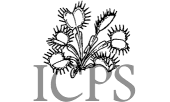Carnivorous Plant Newsletter
Volume 33, Number 1, March 2004, page 19-22
New Cultivars
Dionaea ‘Clayton’s
Red Sunset’
Nepenthes ‘Hortulanus
Otten’
Pinguicula ‘Florian’
Sarracenia ‘Bug Scoop’
Sarracenia leucophylla ‘Hurricane
Creek White’
Sarracenia ‘Bug Scoop’
Submitted: 21 February 2002
The parentage of this plant is Sarracenia x courtii x S. leucophylla = (S. purpurea x S. psittacina) x S. leucophylla. The cross between the Sarracenia x courtii and Sarracenia leucophylla parents was made by the author on 20 March 1999. The Sarracenia leucophylla parent was from Chipola, Florida.
This cross exhibits the bug-capturing lure of Sarracenia leucophylla--as soon as each new pitcher opens, insects are attracted to become food for the plant. The coloration inherited from the Sarracenia leucophylla is definitely visible, but the flared pitcher opening is more similar to that of Sarracenia x courtii. This is a very vigorous clone. Vegetative propagation will be needed to keep the features of this plant. See Figure 2.
The cultivar was named on 21 February 2002 by the author.
--- Dean Cook • Oregon • USA
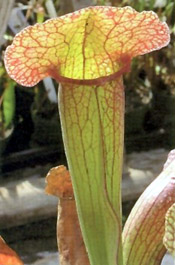
Figure 2: Sarracenia ‘Bug Scoop’. Photograph by Dean Cook.
Sarracenia leucophylla ‘Hurricane Creek White’
Submitted: 8 September 2002
As I described in my other article in this issue (see pages 4-5), Hurricane Creek Alabama was a site with a beautiful kind of large, snow white Sarracenia leucophylla. I obtained specimens from this site before it was completely destroyed, and have found that these plants are still remarkably beautiful in cultivation. I have designated the cultivar name Sarracenia leucophylla ‘Hurricane Creek White’ (see Back Cover) as a memorial for the white plants from Hurricane Creek.
Since having raised this plant under different conditions (both natural and artificial) for over twelve years, I can attest to not only its adaptability and robustness, but also its spectacular beauty especially in the late summer and fall when prime leaf pitcher production occurs. Under optimum environmental factors such as proper hydrology, soil composition, and sunlight, it reproduces vegetatively well and produces an abundance of seed even when selfed. (Seed production is a good way to raise a large number of Sarracenia that have the characteristics of this cultivar. In order to maintain this cultivar’s unique hardiness, color, and size characters, do not attach the cultivar name to any seedlings that do not show the large white pitchers of this Sarracenia leucophylla cultivar.) It has shown an apparent strong resistance to disease and infection by both fungus or bacteria as evident by the absence of any documented mortality in any of the specimens over the twelve year period I have carried them. In brief, it is a superb specimen for growing by anyone who likes an attractive and dependable Sarracenia.
It is important to reiterate that this very white Sarracenia leucophylla cultivar is not anthocyanin-free. When one sees this cultivar for the first time, it is easy to mistake it for the anthocyanin-free form often sought after by many carnivorous plant admirers. Mature late summer leaves are a bright white with no visible red venation. The basal crowns are red, but require close inspection to see this feature. Only if there is some type of damage to the leaf pitcher will a red infusion around this injury be visible. The leaf production in spring varies from a few nice leaves to occasionally none at all, especially if there is heavy flower production.
--- John H. Hummer • Virginia • USA
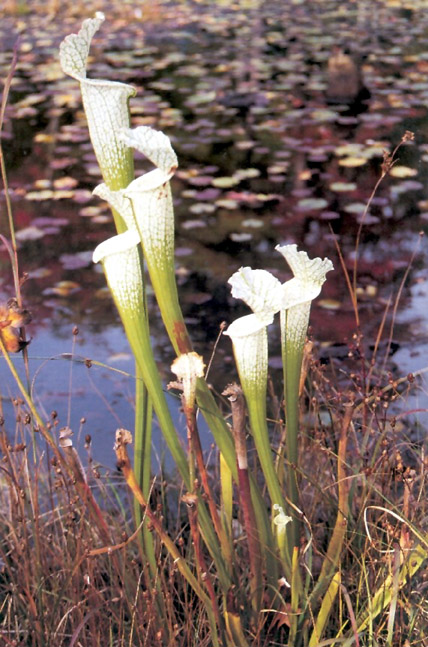
Back Cover: Sarracenia leucophylla 'Hurricane Creek White'. Photograph by John Hummer.
Nepenthes ‘Hortulanus Otten’
Submitted: 5 December 2002
It was 1995 when in the collection of the Leiden Botanic Garden, The Netherlands, two of the Bornean Nepenthes were flowering simultaneously. One of them was Nepenthes hirsuta and producing male flowers, the other one was the very distinctive species N. bicalcarata.
Being a horticulturist I was well aware of the rare combination and also quite curious, normally we only grow species in our collection but this was a nice opportunity to make a cross-pollination between these two species. After three years when the seedlings of this hybrid produced their first nice pitchers, I made a selection of five individuals with a variety in pitcher size, form and color. I believe one is worth growing as a new cultivar, because it is so different in size and form (see Figure 1, page 21).
This cultivar is distinguished by its very robust lower pitchers which measures about 18 cm (7 inches) in length, and the opening of the mouth is between 6 and 8 cm (2.5-3 inches) wide. The interior of the pitchers is almost lime green and the typical teeth of N. bicalcarata are well presented. The entire exterior of the pitcher is lime green with brown hairs which presents a dark golden glow in full light, and the pitcher wings are well formed. The upper pitchers are somewhat smaller but with the same external texture, are more bulging, and narrow towards the tendril, the latter being covered with long brown hairs. The pitcher’s lid is slightly more rounded than the lid of the lower pitcher.
To maintain these unique characters, this cultivar should only be reproduced by vegetative means.
It is named in honour to Mr. Karel Otten, former Curator of the Botanic Garden in Gent, Belgium.
--- Art Vogel, Assist. Curator • Leiden Botanic Garden • Rapenburg 73 • 2300 RA Leiden • The Netherlands
 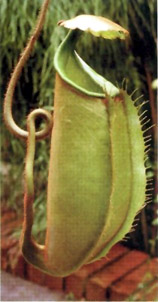
Figure 1: Nepenthes ‘Hortulanus Otten’; lower pitcher (left), upper pitcher (right). Photographs by Art Vogel.
Pinguicula ‘Florian’
Submitted: 9 March 2003
This new cultivar originated from a cross I did in 1998 between P. debbertiana and P. jaumavensis (the latter plant was a clone with particularly pale flowers). When I sowed the resulting seed in 1999, I obtained several seedlings. When these matured, I retained one plant which had the most interesting flower. I have named the plant Pinguicula ‘Florian’, after my oldest son’s first name.
The hybrid has two different rosette types. The winter rosette consists of up to 100 spatulate, non-carnivorous winter leaves, each up to 2.5 cm long and up to 0.6 cm wide. These are mostly green, but sometimes the leaves can be green with red highlights.
The summer leaves are less numerous (up to 25), and are spatulate to obovate in form with the outermost part of the leaf having an upturned margin. The coloration of the leaves is mostly green-brown to green-red.
The plants flower mostly when in the winter rosette stage, and produce up to 5-8 flowers per year. See the photograph of flower in Figure 3.
The two corolla lips form an angle between 20 and 45 degrees. The two lobes of the upper lip overlap slightly and are spatulate to obovate in form, up to 1.2 cm long and 0.9 cm at the widest point. The three lobes of the lower lip are also spatulate to obovate, up to 1.5 cm long and 0.9 cm at the widest point. The lobes are pink, with darker parallel veins that run from the lobe base into the throat. The proximal palate surface bears two rows of yellow to light green hairs. The corolla tube is short (0.2 cm), with two rows of yellow hairs at its base. The outside of the tube is whitish to pale green, and also bears parallel venation. The (light green) spur can be up to 1.2 cm long and bears brown to reddish venation. All five calyx lobes are obovate, light green and approximately 0.4 cm long. The lower two calyx lobes are almost parallel to each other. The stigmata is ochre. The flower stalk is up to 16 cm long, and bears some glandular hairs near the top.
This cultivar has been distributed to growers world wide since 2001, and is now established in several collections. More photographs of it, and its parental plants can be seen on my website http://www.gluch.info .
--- Oliver Gluch • Harthausen • Germany • oliver@gluch.info
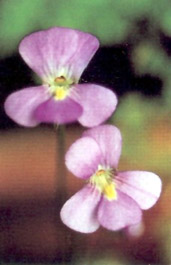
Figure 3: Pinguicula ‘Florian’. Photograph by Oliver Gluch.
Dionaea ‘Clayton’s Red Sunset’
Submitted: 31 March 2003
This plant is an all red flytrap which I have named Dionaea ‘Clayton’s Red Sunset’. It regularly grows up to 25 cm (10 inches) across, although extremely slowly, and is one of the wonders of the flytrap world. It first came to light twelve years ago, having originated from a batch of seed imported into Australia from the U.S.A. The features which make this cultivar different from other red flytraps (such as Dionaea ‘Red Dragon’ or Dionaea ‘Red Piranha’) are the following:
A) The petioles are almost always long and thin. The other red flytraps have quite wide petioles, especially during the winter.
B) During the winter, this cultivar totally loses its leaves, at least when grown in a Mediterranean climate. The other red flytraps retain at least some of their leaves.
C) This plant is totally red, except for the teeth on immature traps, which are yellow. Dionaea ‘Red Dragon’ incorporates green as part of its coloration at some time during its growth cycle.
D) The color of this cultivar is a deeper, darker red than the other currently named red flytrap cultivars. It becomes almost black in the summer if exposed to full sunlight.
E) The marginal spines on this cultivar are normal, and not sawtooth as in Dionaea ‘Red Piranha’.
To keep this cultivar true to its name, it should be reproduced by vegetative means. It responds well to standard flytrap cultivation methods, but takes up to four years to mature. Plants are available from our nursery. See Figure 4.
--- Colin Clayton • Triffid Park • 257 Perry Road • Keysborough • Victoria 3173 • Australia • triffids@triffidpark.com.au
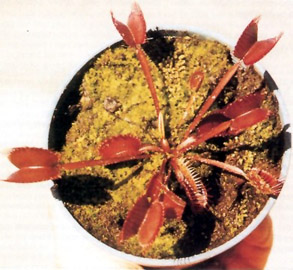
Figure 4: Dionaea ‘Clayton’s Red Sunset’ growing in a 17 cm (7 inch) pot.
|
